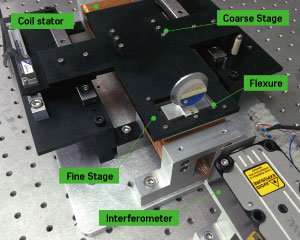Integrated design strategy lowers the mass and costs of motors that move objects nanometers at a time

Probing intricate cells or high-tech microchip components requires 'nanopositioners' that can scan large areas with extremely small steps. Normally, these positioners have separate fine- and coarse-movement stages, but A*STAR researchers have introduced a parallel-actuated system that integrates the two units for improved energy efficiency.
When engineers design bearings for guiding moving parts, they typically work with tolerances of a few micrometers. Nanopositioning devices, however, need precision standards up to a thousand times greater. To achieve this kind of precision motion, piezoelectric crystals that slightly expand or contract with voltage stimulation are usually combined with an active feedback sensor. Then, the fine-motion crystal is mounted on to the moving part of a linear actuator capable of large displacements in a single stroke.
This type of configuration, known as serially-actuated dual-stage design, has inherent problems according to Daniel Tat Joo Teo from the Singapore Institute of Manufacturing Technology (SIMTech) at A*STAR. "In a traditional serially-actuated design, power cables are linked to the fine-motion stage to energize the actuators. These cables cause substantial disturbance, and limit the performance of the entire motion system."
Teo and his collaborators from SIMTech and the National University of Singapore considered a different approach to constructing nanopositioners. Instead of conventional piezoelectric actuators, they chose a magnetic linear motor as a means to establish fine motion. Then, they coupled this motor with hinge-like flexure bearings attached to the coarse translator. The flexure system offers nanometer-scale movement without dry friction and critically, can be controlled with the same electromagnetic machinery used to drive the coarse motor—eliminating the weight and expense of troublesome cables.
The challenge with this integrated design, notes Teo, lies in finding the right combination of mechanical characteristics such as stiffness and damping. While conventional positioners can analyze the properties of controllers, actuators, and mechanical stages independently, the team had to find a way to optimize these three elements concurrently. To do so, they established an analytical model capable of predicting how applied force 'ripples' through the nanopositioner and impacts small-scale movements.
Fabrication of an experimental prototype revealed the potential of the researchers' integrated positioner and analytical model. As measured by a laser interferometer, the device could move in 20 nanometer steps without being sensitive to millimeter-scale coarse movements—findings that may usher in a new era of inexpensive nanopositioning devices.
"The parallel-actuated dual-stage design gives reasonably good performance even with a low-cost coarse stage," says Teo. "We plan to commercialize the system to benefit our manufacturing industry."
More information: Haiyue Zhu et al. A Flexure-Based Parallel Actuation Dual-Stage System for Large-Stroke Nanopositioning, IEEE Transactions on Industrial Electronics (2017). DOI: 10.1109/TIE.2017.2677306



















